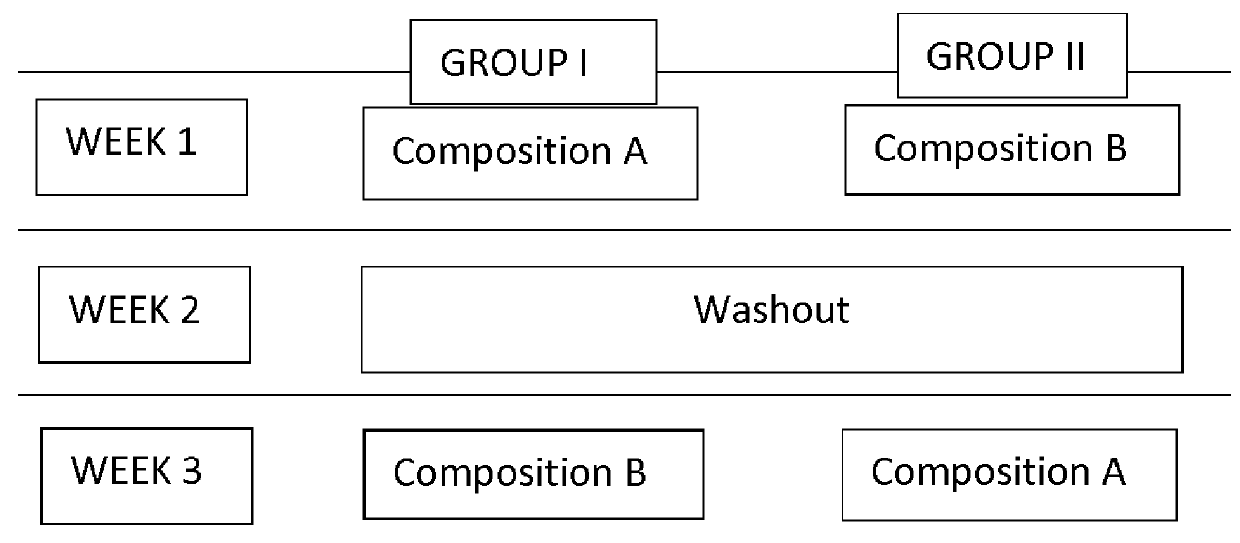Composition for use in the prevention and/or treatment of oncologic treatment induced orogastrointestinal mucositis
- Summary
- Abstract
- Description
- Claims
- Application Information
AI Technical Summary
Benefits of technology
Problems solved by technology
Method used
Image
Examples
example 1
Study Of Prevention of Otiom
[0116]1.1.—Subjects
[0117]Fifty four patients (26 men and 28 women) aged from 12 to 95 with different cancer diagnosis (Table 3) and different oncologic treatments (surgery, chemo-radiotherapy, radiotherapy or a combination of them) (Table 4) were included in the study.
TABLE 3Cancer diagnoseTotal casesTest groupControl groupHead and neck1477Colorectal413Stomach220Gastrointestinal carcinoid110Leukemia550Lymphoma431Breast1073Melanoma110Pancreatic220Prostate321Lung871
TABLE 4TreatmentNumber of patientsSurgery + Chemotherapy + Radiotherapy34Surgery + Chemotherapy7Chemotherapy10Surgery + Radiotherapy2Chemotherapy + Radiotherapy1
[0118]1.2.—Inclusion and Exclusion Criteria
[0119]Inclusion
[0120]Patients with a cancer diagnosed, who require an oncologic treatment as chemotherapy and / or radiotherapy with or without surgery. Patients with a good oral hygiene habit and with the intention of using the products following the protocol received.
[0121]Exclusion
[0122]Those pa...
example 2
Study of Treatment of Otiom
[0150]2.1.—Subjects
[0151]Twenty patients (8 men and 12 women) aged from 45 to 88 with different diagnosed cancers (Table 7) and different oncologic treatments (surgery, chemo-radiotherapy, radiotherapy or a combination of them) (Table 8) were included in the study.
TABLE 7Cancer diagnoseNumber of patientsHead and neck9Colorectal3Lymphoma1Breast4Prostate1Lung1Esophagus1
TABLE 8TreatmentNumber of patientsSurgery + Chemotherapy + Radiotherapy11Surgery + Chemotherapy2Chemotherapy5Surgery + Radiotherapy1Chemotherapy + Radiotherapy1
[0152]2.2.—Inclusion and exclusion criteria
[0153]Inclusion Criteria
[0154]Patients with diagnosed cancer, undergoing an oncologic treatment as chemotherapy and / or radiotherapy, with or without surgery, who having had developed mucositis in a previous cycle of treatment were noticing the onset of mucositis in a current cycle.
[0155]Oral hygiene measures were instructed by the oncological team, varying from normal oral hygiene measures to p...
example 3
Comparative Study of Prevention
[0184]3.1.—Subjects
[0185]60 patients (27 men and 33 women) aged from 25 to 78 with different cancer diagnosis and different oncologic treatments were included in the study.
[0186]3.2.—Inclusion and Exclusion Criteria
[0187]Inclusion
[0188]Patients with a cancer diagnosed, who require an oncological treatment which has not started yet. Patients intending to follow the protocol and having good oral hygiene.
[0189]Exclusion
[0190]Those patients who did not comply with the inclusion criteria. Moreover, patients that were using the tested products before starting the study were not allowed to participate.
[0191]3.3.—Study Design
[0192]Three randomized groups of 20 patients each were created.
[0193]Group 1: Composition comprising olive oil, TMG and xylitol.
[0194]Group 2: Composition comprising olive oil, but not including TMG nor xylitol.
[0195]Group 3: Composition comprising xylitol and TMG, but not including olive oil.
[0196]The protocol consisted of:[0197]Brushing ...
PUM
| Property | Measurement | Unit |
|---|---|---|
| Fraction | aaaaa | aaaaa |
| Fraction | aaaaa | aaaaa |
| Fraction | aaaaa | aaaaa |
Abstract
Description
Claims
Application Information
 Login to View More
Login to View More - R&D
- Intellectual Property
- Life Sciences
- Materials
- Tech Scout
- Unparalleled Data Quality
- Higher Quality Content
- 60% Fewer Hallucinations
Browse by: Latest US Patents, China's latest patents, Technical Efficacy Thesaurus, Application Domain, Technology Topic, Popular Technical Reports.
© 2025 PatSnap. All rights reserved.Legal|Privacy policy|Modern Slavery Act Transparency Statement|Sitemap|About US| Contact US: help@patsnap.com


